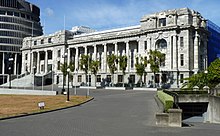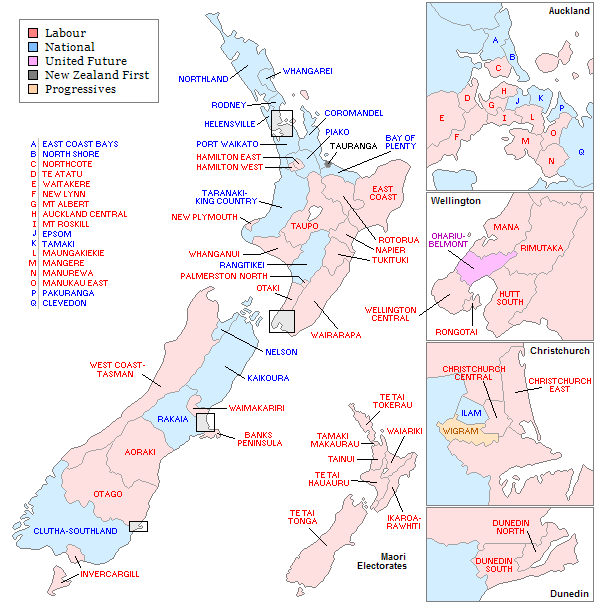47th New Zealand Parliament
| 47th Parliament of New Zealand | |||||
|---|---|---|---|---|---|
| |||||
 | |||||
| Overview | |||||
| Legislative body | New Zealand Parliament | ||||
| Term | 26 August 2002 – 2 August 2005 | ||||
| Election | 2002 New Zealand general election | ||||
| Government | Fifth Labour Government | ||||
| House of Representatives | |||||
 | |||||
| Members | 120 | ||||
| Speaker of the House | Margaret Wilson — Jonathan Hunt until 3 March 2005 | ||||
| Leader of the House | Michael Cullen | ||||
| Prime Minister | Helen Clark | ||||
| Leader of the Opposition | Don Brash — Bill English until 28 October 2003 | ||||
| Sovereign | |||||
| Monarch | Elizabeth II | ||||
| Governor-General | Silvia Cartwright | ||||
The 47th New Zealand Parliament was a term of the Parliament of New Zealand. Its composition was determined by the 2002 election, and it sat until 11 August 2005.[1][2]
The Labour Party and the Progressive Party, backed by United Future, commanded a majority throughout the 47th Parliament. The Labour-led administration was in its second term. The National Party, although dealt a significant blow in the last election, remained the largest opposition party. Other non-government parties were New Zealand First, ACT, the Greens, and (from mid-2004) the Māori Party.[1]
The 47th Parliament consisted of 120 representatives. Sixty-nine of these were chosen by geographical electorates, including seven Māori electorates. The remainder were elected by means of party-list proportional representation under the MMP electoral system.[1]
Electoral boundaries for the 47th Parliament
[edit]Overview of seats
[edit]The table below shows the number of MPs in each party following the 2002 election and at dissolution:[citation needed]
| Affiliation | Members | ||
|---|---|---|---|
| At 2002 election | At dissolution | ||
| Labour | 52 | 51 | |
| Progressive | 2 | 2 | |
| United Future CS | 8 | 8 | |
| Government total | 62 | 61 | |
| National | 27 | 27 | |
| NZ First | 13 | 13 | |
| Green C | 9 | 9 | |
| ACT | 9 | 9 | |
| Māori Party | Not yet founded | 1 [1] | |
| Opposition total | 58 | 59 | |
| Total |
120 | 120 | |
| Working Government majority [2] | 4 | 2 | |
Notes
- ^CS United Future supported the Labour-Progressive coalition on a confidence and supply basis.
- 1 Tariana Turia resigned as MP and from the Labour Party on 30 April 2004 following the foreshore and seabed controversy. She won the resulting by-election under the banner of the new Māori Party.
- 2 The Working Government majority is calculated as all Government MPs less all other parties.
- ^C The relationship differs from the one in the last Parliament in that the Greens are not now providing a guarantee of confidence and supply. The agreement notes that the government parties and the Green party share many similar aspirations and are keen to work together.
Initial composition of the 47th Parliament
[edit]The initial members of the 47th Parliament were as follows:[3]
By-elections during 47th Parliament
[edit]There was one by-election held during the term of the 47th Parliament.[4]
| Electorate and by-election | Date | Incumbent | Cause | Winner | |||
|---|---|---|---|---|---|---|---|
| Te Tai Hauauru | 2004 | 10 July | Tariana Turia | Resignation | Tariana Turia | ||
Summary of changes during term
[edit]- Graham Kelly, a Labour list MP, left Parliament on 29 July 2003 to take up a position as High Commissioner to Canada.[5] Moana Mackey, the next candidate on Labour's party list, entered Parliament in his place.[6]
- Donna Awatere Huata, an ACT list MP, was officially declared an independent on 11 November 2003. This followed her suspension from the ACT caucus on 11 February 2003 after allegations of fraud were made against her. After a lengthy legal fight which went all the way to the Supreme Court, she was expelled from Parliament on 19 November 2004.[7] She was replaced by Kenneth Wang on 30 November.[8]
- Tariana Turia, the Labour MP for Te Tai Hauauru, resigned from Parliament over the foreshore and seabed issue on 17 May 2004.[9] On 10 July, Turia won the resulting by-election under the banner of the new Māori Party, and took her seat again on 27 July.[10]
- Jonathan Hunt, a Labour list MP, left Parliament on 30 March 2005 to take up a position as High Commissioner to the United Kingdom.[11] Lesley Soper, the next candidate on Labour's party list, was sworn in to replace him on 5 April.[12]
Seating plan
[edit]As on 10 August 2004
[edit]The chamber is in a horseshoe-shape.[13]
References
[edit]- ^ a b c Cleland, Grant; Wilson, John (20 August 2002). "Final Results 2002 General Election andTrends in Election Outcomes 1990 — 2002". Background Note (6): 1–9 – via New Zealand Parliamentary Library.
- ^ "Dissolving the Parliament of New Zealand - 2005-ps5264 - New Zealand Gazette". gazette.govt.nz. Retrieved 18 January 2021.
- ^ "MPs in the 47th Parliament". NZ Herald. 12 August 2002. Retrieved 19 January 2021.
- ^ MacBean, Alex; Wilson, John (15 September 2016). "By-elections in New Zealand: 1905—2015". www.parliament.nz. Archived from the original on 18 October 2020. Retrieved 19 January 2021.
- ^ "New High Commissioner to Canada". www.Beehive.govt.nz. 21 December 2002. Archived from the original on 9 February 2019. Retrieved 19 January 2021.
- ^ "Moana Mackey joins mother Janet in Parliament". nzhistory.govt.nz. 20 July 2018. Retrieved 18 January 2021.
- ^ "Awatere Huata expelled". TVNZ. 19 November 2004. Archived from the original on 18 January 2021. Retrieved 19 January 2021.
- ^ "New MP joins Act in Parliament". The New Zealand Herald. 23 November 2004. Retrieved 16 February 2010.
- ^ Berry, Ruth; Tunnah, Helen (30 April 2004). "Turia quits Labour, stripped of portfolios". The New Zealand Herald. Retrieved 29 July 2020.
- ^ "By-Election Results – Te Tai Hauauru". Chief Electoral Office. Retrieved 19 September 2014.
- ^ "Goff announces new High Commissioner to London". The Beehive. Retrieved 18 January 2021.
- ^ "New list MP for Labour Party". elections.nz. 4 April 2005. Retrieved 18 January 2021.
- ^ "Debating Chamber". clerk.parliament.govt.nz. 10 August 2004.

